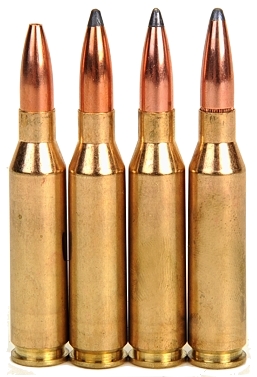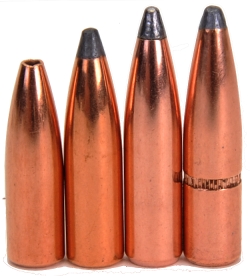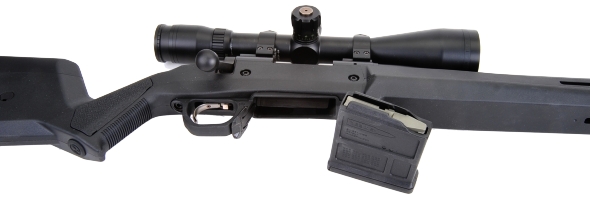
The weather in Maine has been problematic when it comes to punching holes in targets; deep drifts from firing line to down range and short legs to make the journey. Still, the Remington Model 700 Magpul is so much fun, it was worth the sacrifice and my wife and I have no plans for additional children.
The 260 Remington’s reputation usually reflects heavy for bore bullet weights. The high BC target bullets typically cut off at 140 grains, the high SD bullets can surpass 160 grains. The first reputation is the result of the 260 Remington’s showing in long range competitive shooting. The second reputation is a byproduct of a myriad of Swedish moose hunting articles that embrace the heavy, round nose 6.5mm bullet. I am not a competitive shooter and I do not hunt Swedish moose.
My prior use of the 260 Remington in other firearms seemed to coalesce in the range of 120 to 130 grains where velocity exceeds 2900 fps and bullet construction suits medium to large thin skilled game. After handloading weights from 85 grains to 160 grains, the lightest seemed fragile and rapidly shed velocity, the heaviest lacked uniform expansion. A typical 260 Remington problem the Remington rifle overcomes is heavy/long bullet instability. The rifle’s 8″ twist easily stabilized very long 160 grain round nose bullets and 140 grain VLD type bullets.
Some handloads for checkout…

| Brand | Mfg # | Type | Grains | Construction | Length “ | B.C. |
| Sierra | 1710 | HP | 100 | Lead Core | 0.934 | 0.259 |
| Sierra | 1720 | Spitzer SP | 120 | Lead Core | 1.082 | 0.356 |
| Nosler | 16320 | Partition SP | 125 | Lead Core | 1.175 | 0.449 |
| Hornady | 2620 | Interlock SP | 129 | Lead Core | 1.175 | 0.445 |
Four bullets out of a ninety nine 0.264″ bullets that are generally available were loaded for the Remington Model 700 Magpul checkout; from coyote to elk.
 There are many specialty bullets for this bore; hunting and competition, conventional jacketed lead and solid copper alloy. Prices run from 18¢ cents to $1.24 per bullet. The four bullets used for this project typically run 30¢ with the exception of the Nosler Partition which is a 68¢ bullet.
There are many specialty bullets for this bore; hunting and competition, conventional jacketed lead and solid copper alloy. Prices run from 18¢ cents to $1.24 per bullet. The four bullets used for this project typically run 30¢ with the exception of the Nosler Partition which is a 68¢ bullet.
The bullets selected are flat base. The Partition has a slightly heel bevel, but not to the degree it would qualify as a boat tail. None are VLD type. The selection was based upon experience with each bullet’s effectiveness and accuracy and a need for minimal case intrusion to preserve the 260 Remington’s modest case capacity while meeting the short cartridge overall length spec.
Standard large rifle primers were incorporated into all handloads, a departure from my chronic and inexplicable use of magnum primers. Some of the loads were dense, none were crimped despite the presence of a single bullet with a cannelure, and my concern was that the magnum start pressure might prematurely drive a bullet forward atop all of that dense powder and reduce charge pressure. It is my lame theory and I am sticking to it.
Powder selections are… mundane. I realize it has become the nature of the powder companies to change from one every two hundred year new product introductions to changing packaging every other day and introducing new powder types one per week. Oddly enough, I’ve not had good success with low flash and copper fouling cleansing powders. They fall short on velocity and long on consumption and price. Insert razzing sound effect.
 |
Warning: Bullet selections are specific, and loads are not valid with substitutions of different bullets of the same weight. Variations in bullet material and length will alter net case capacity, pressure and velocity results. Primer selection is specific and primer types are not interchangeable. These data represents maximum loads in our firearms and test equipment and may easily be excessive in other applications. All loads should be reduced by 3%, and developed following safe handloading practices as represented in established reloading manuals produced by component manufacturers. Presentation of these loads does not constitute a solicitation for their use, nor a recommendation.
|
||||||||||||||||||||||||||||||||||||||||||||||||||||||||||||||||||||||||||||||||||||||||||||||||||||||||||||||||||||||||
|
|||||||||||||||||||||||||||||||||||||||||||||||||||||||||||||||||||||||||||||||||||||||||||||||||||||||||||||||||||||||||
The handloads selected are not a casual or untested effort, however, none of the bullets selected are intended for target work. The bullets have been used in a variety of non-magnum 6.5mm applications with some frequency; 260 Remington, 6.5×55 Swede and 6.5 Creedmoor. Yes, it would be possible to assemble handloads that would be less accurate, but that would be an issue of ammunition and not the rifle. I did establish a benchmark with factory Federal Vital-Shok 120 grain ammunition with consistent sub MOA performance at mid 2900 fps performance.
Rolling to a stop
The real star of this story is the Remington Model 700 Magpul. Not a single hiccup during the entire process. The short, stout Remington action easily handled the handloads; no sticking cases, minimal brass stretch and expansion. Recoil was soft and the front end stayed pretty close to the rest after each shot. Shooting comfort was excellent, changing magazines was a snap and bolt stroke was… brief. Action and barrel temp never got much pass warm with reasonable cycles of live fire. Remington did a very nice job of putting this package together.


Email Notification